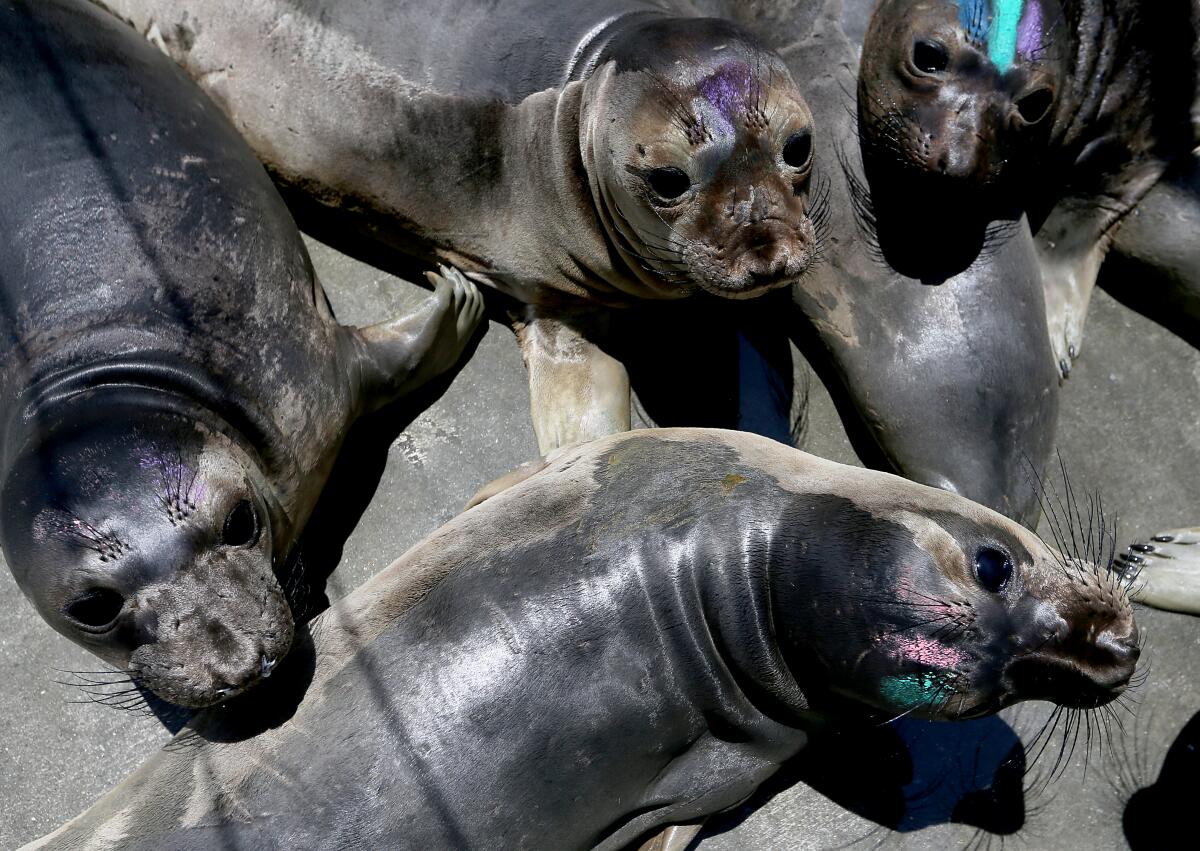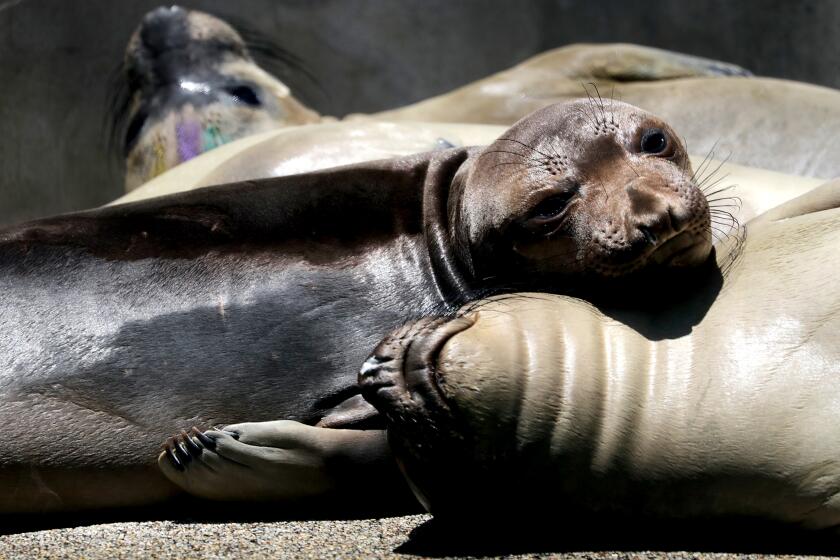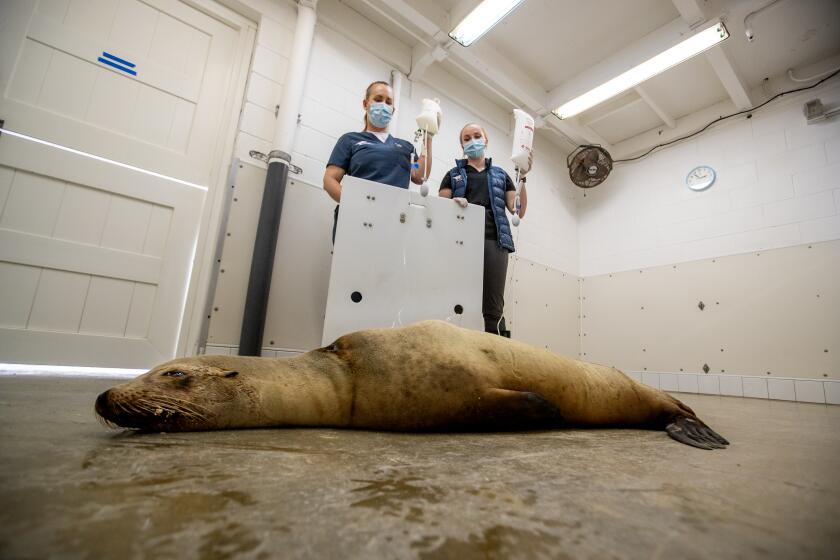An algae bloom devastated sea mammals last year. L.A. wants to improve its rescue efforts

- Share via
A nightmarish scene unfolded in the summer of 2023 across Los Angeles County beaches as hundreds of sick marine mammals washed ashore and became stranded in the sand. Beachgoers witnessed animals seizing, foaming at the mouth and dying due to a toxic algae bloom.
City leaders and residents scrambled to help as the nonprofit Marine Mammal Care Center in San Pedro worked to rescue and rehabilitate ill seals, sea lions and dolphins. The center quickly filled to capacity, said Chief Executive Officer John Warner, and it became clear there were not enough resources to save every animal.
Roughly seven months later, the Los Angeles City Council is revisiting the matter, with the goal of becoming better prepared for the next algae bloom. The council passed a motion Wednesday to request a report from the Department of Animal Services on marine mammal rescue protocols, including a review of how the crisis was handled last summer.
The motion also asks the city administrative officer to identify grant opportunities and other funding sources to aid in marine mammal rescue.
“It was a really tragic thing to see,” said Councilmember Traci Park, who introduced the motion and represents District 11, which includes neighborhoods adjacent to the ocean. “I want to make sure that we have the essential resources that we are going to need when this happens again.”
More than 1,000 marine mammals along the Southern California coast have gotten sick or died because of the bloom of toxic algae, according to the National Oceanic and Atmospheric Administration.
Algae blooms are becoming more common due to climate change, and the one last year was the largest ever recorded in Southern California. The bloom consisted of an overgrowth of pseudo-nitzschia marine algae, which produces the neurotoxin domoic acid.
While domoic acid doesn’t harm shellfish or fish, it can be fatal when ingested by marine mammals. Sick mammals desperate to rest last summer ended up on crowded beaches, where they clashed with beachgoers who got too close.
“These wonderful, charismatic animals that we all love to watch can become unpredictable when they’re sick,” Warner said. “It creates a very dangerous situation for people because the animals act aggressively.”
The Marine Mammal Care Center partnered with government officials in June to create a cordoned off resting area for seals and sea lions stranded on Venice beaches. The resting area provided a safe space away from crowds for sick animals who could not be taken to the center due to space constraints.
Warner said the center could care for 100 to 130 animals at a time. There were roughly 150 more stranded animals that it could not take in, he said.
“We had an animal welfare problem, a public safety problem and a public health problem,” Warner said of the situation.
Lisa Jordan, a Venice resident whose home was feet from the animal-resting zone, said it was impossible to go to the beach in her neighborhood without seeing sick marine mammals on the shore.
Jordan and her community volunteered to guard the resting zone and educate the public about the crisis. She commended city leaders and the Marine Mammal Care Center for setting up the resting zone quickly, but said they could be even more efficient next time.
“Having agreements in place about what to do when this happens would be best for our response and reaction time,” she said.
Sea lions experiencing seizures or sickness due to an ongoing bloom of toxic algae have bitten or behaved aggressively toward beachgoers across Southern California, according to experts.
Park, who was closely involved in the partnership with the Marine Mammal Care Center, said her district rallied together to face the challenge and provide volunteers.
“It was really spectacular,” she said. “It’s a sad set of circumstances, but a great opportunity for the community to unite around something that matters to us.”
Park said she introduced her motion because it’s likely an algae bloom will happen again and thousands of marine mammals will be sickened, affecting not just the ecosystem but also Los Angeles communities. There are still unanswered questions regarding who is available and authorized to rescue, transport and rehabilitate the animals.
Currently, the Marine Mammal Care Center is the only organization approved by the National Oceanic and Atmospheric Administration to rescue and rehabilitate marine mammals in Los Angeles County.
“This motion gets at all of those questions so that when the next incident happens, we all have a clear understanding of what’s available to us,” Park said. “We’re going to continue to need additional resources and protocols and funding to help us protect the wildlife that depend on our ocean.”
More to Read
Sign up for Essential California
The most important California stories and recommendations in your inbox every morning.
You may occasionally receive promotional content from the Los Angeles Times.













